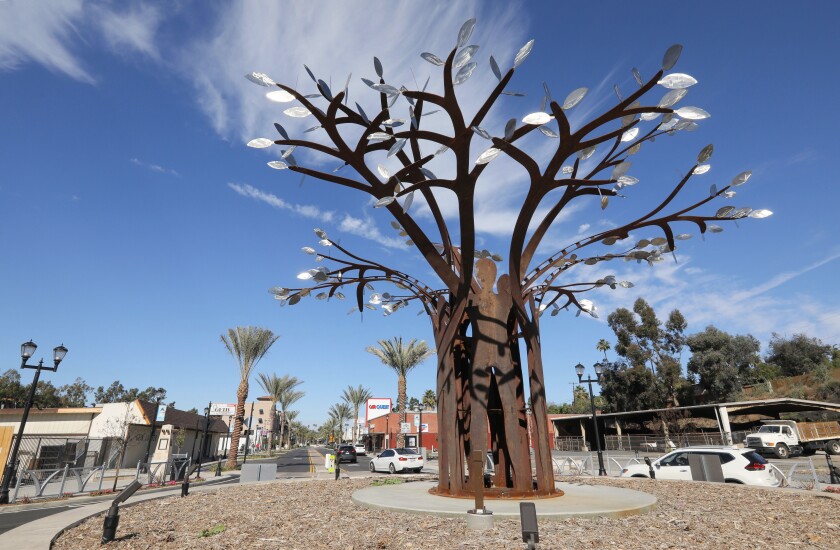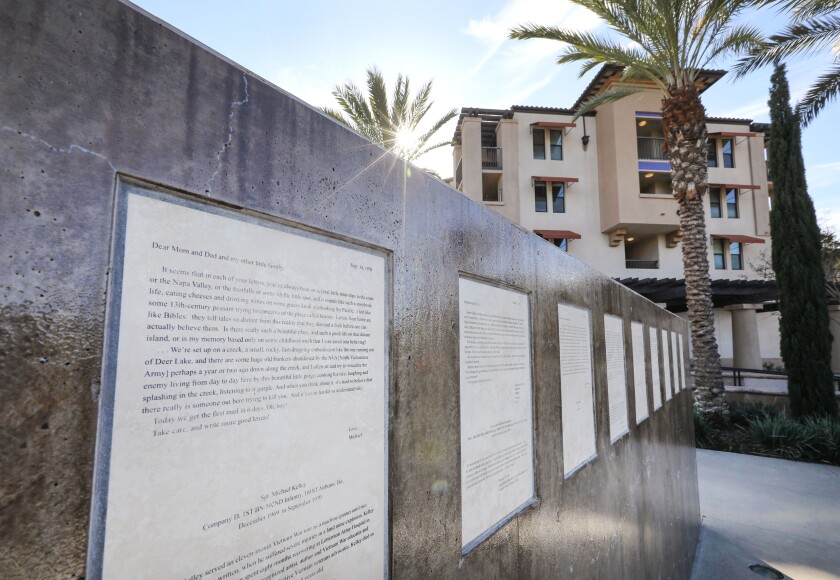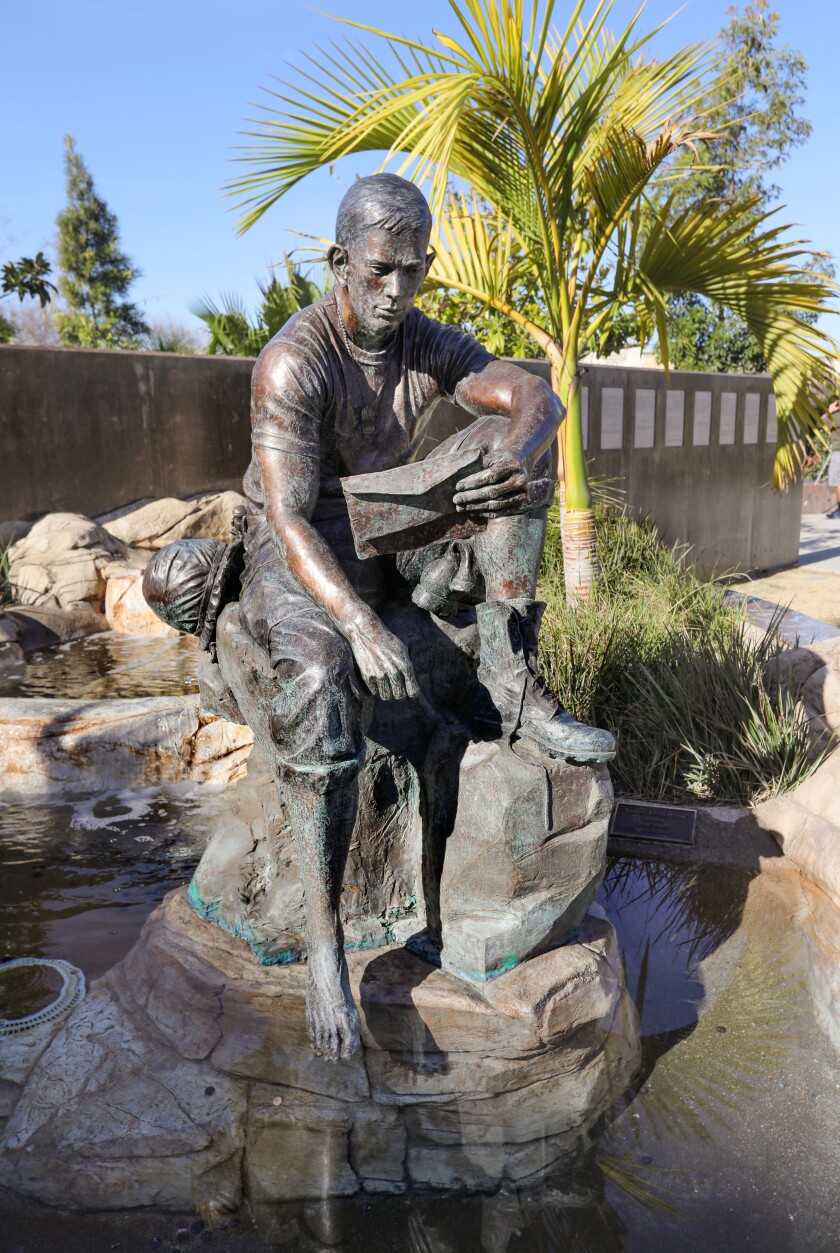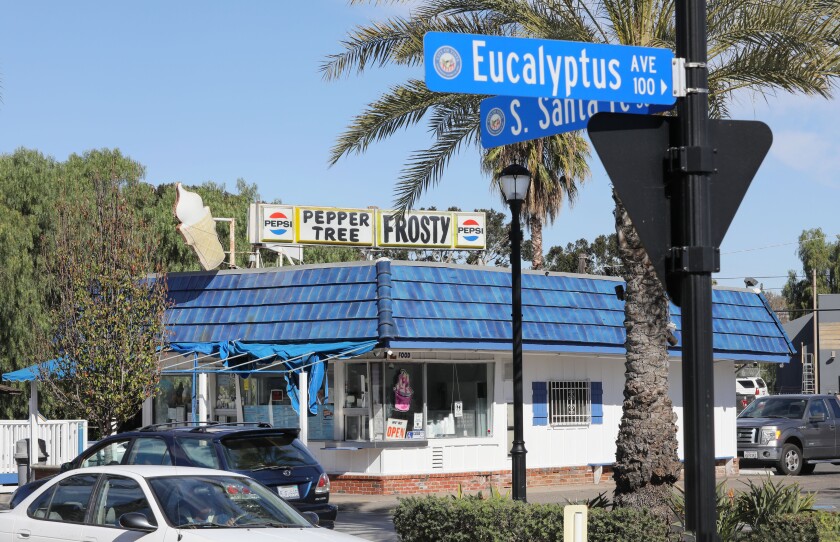After decades of planning, six years of construction and $20.2 million in spending, Vista’s long-awaited Paseo Santa Fe improvement project is finally complete.
The 0.8-mile stretch of South Santa Fe Avenue between Vista Village and Civic Center drives is the latest piece in a downtown revitalization project that has been under way for more than 20 years.
Since the Paseo project kicked off in May 2014, the corridor has undergone a massive renovation that included the undergrounding of utility lines, narrowing of the road from four lanes to two, two new roundabout traffic circles, new sidewalks, streetlights and landscaping, a veterans memorial park, public art pieces and two arched “Vista” monument signs at either end of the Paseo roadway area. The project was completed in December.
Local residents and merchants are enthusiastic about the finished project and a city official said the improvements have generated a tremendous amount of new interest from business owners and private investors. But the project has also had its hiccups along the way. Business owners complained in the past about lost business due to the years-long road construction, and the monument arches had to be redesigned at high cost after complaints from residents.
But the potential for new mixed-use projects, restaurants, breweries and businesses along the finished roadway is high, according to Kevin Ham, the city’s director of economic development. He said discussions are now under way with virtually every property owner in the corridor to renovate or redevelop their land or buildings. He describes the approaching wave of business as a second “roaring ‘20s,” referring to the boom times experienced in the 1920s following World War I and the 1918 global pandemic.
“As we come out of this pandemic, people will have been in their homes looking for opportunities once it’s safe enough to gather with people, and to use some of that money that they’ve saved,” Ham said. “You’ll see people spending that disposable income, and uses coming in to serve that specific need. That’s on the horizon. Most economists are talking about this now.”

Hector Estrada and Shelly Kentner, co-owners of 508 Tavern in Vista, are excited with the completion of the city’s Paseo Santa Fe corridor.
(Courtesy photo)
Vista native Shelly Kentner is a believer. She and her husband Hector Estrada opened their 508 Tavern in the heart of the Paseo Santa Fe project in May 2017. The past three years have been difficult due to the construction and the pandemic, but she’s thrilled with the improvement project results. In 2019, she and her husband signed a 10-year lease on the property and they’re planning to build a side patio soon.
“I think Vista needed this,” she said. “We were a little bit behind having a hopping downtown area. So we’re excited to be on the forefront. We can’t wait for people to give Vista a chance again and be the new word on the street.”

“Aspire,” a new sculpture by artists Melissa Ralston and Robert Rochin, has been installed as part of the Paseo Santa Fe improvement program at South Santa Fe and Guajome Street in Vista.
(Charlie Neuman/The San Diego Union-Tribune)
Santa Fe revamp
Beginning in the 1920s, Santa Fe Avenue was a heavily traveled commercial corridor of the community that would incorporate as Vista in 1963. Among its first tenants was Geib Lumber at 437 S. Santa Fe, which opened in 1928. Through the 1960s, the roadway thrived with dozens of small businesses that includes restaurants, bars, retail shops, small office buildings, auto supply stores and the town’s beloved Pepper Tree Frosty ice cream stand, which opened in 1953.
But as traffic shifted north and south to the streets now know as Vista Village and Civic Center drives, that stretch of South Santa Fe gradually became neglected by cars and consumers. By the early 2000s, it was peppered with boarded-up shops and empty weed-choked lots. A homeless community grew and graffiti began to proliferate.
Ham said city officials had their eyes on improving that section of Santa Fe for decades, but they had bigger priorities to tackle, like the development of the nearby Vista Village district that brought in a shopping center, movie theater, restaurants, a supermarket, big-box retailers and more. Next came improvements to the city’s historic downtown, which routed traffic away from the historic Main Street to the much wider Vista Village Drive.
The Santa Fe project hit another snag a decade ago when the state abolished city redevelopment agencies, which used a portion of property taxes to recruit developers to blighted areas like the Santa Fe corridor. Finally the city cobbled together a mix of grants, public and private funding, donations and more to make the road’s revamp happen beginning in 2014.
Based on a public survey of potential names for the soon-to-be revamped corridor, Paseo Santa Fe was chosen. Paseo means “path” in Spanish and this portion of road is like a path between the two hills on either sides of the road.

At Veterans Memorial Park along South Santa Fe Avenue copies of letters from service members in Vietnam during the war are displayed.
(Charlie Neuman/The San Diego Union-Tribune)
The beginning and the end
The first phase of the project was at the northwest end of the plan area and included one of the most innovative pieces of the puzzle.
For many years before his death in 2009, local developer Carl Pinamonti dreamed of one day building a memorial in Vista to honor the Marines and soldiers who died in the Vietnam War, including his son, Ernie, a 19-year-old Marine who was killed by small arms fire in 1969. In 2000, Pinamonti donated a 3/4-acre parcel of land at Guajome and Mercantile streets to the city with the agreement it would be used for a memorial park.
But the city couldn’t afford to build or maintain a park, and neither could the Pinamonti family, so the land sat vacant. Then in 2011, the city approached Pinamonti’s children and asked if it could swap the original donated land for a city-owned parcel a few blocks away in what would become the Paseo Santa Fe project. The family agreed and raised $100,000 to build a series of sculptures, including a life-size bronze cast of Ernie, reading a letter from home.
Veterans Memorial Park, which the Pinamonti family calls “Ernie’s Place,” opened in April 2016 as one of the first pieces of the Paseo Santa Fe project. Vista resident Mary Ann Pinamonti, who was 18 when her brother died, said the park has brought her family a great deal of comfort over the years and she’s happy to see the road work now complete so more people can visit the park.
“It’s pretty and I think anything the city can do to make things nice gives people pride in their community,” she said. “I’m anxious to see what businesses will go down there because right now it’s a hodge-podge.”

A sculpture of Vietnam War Marine Ernie Pinamonti reading a letter from home at Veterans Memorial Park in Vista.
(Charlie Neuman/The San Diego Union-Tribune)
The memorial park was built next door to Paseo Pointe, a 69-unit affordable-housing apartment building that opened in May 2015. Since then, a market-rate luxury apartment complex has opened a block north at 100 Main St. called The Rylan. Opened in September, the Rylan has 126 units ranging in price from $2,055 for a studio to $4,055 for a two-bedroom.
Still to come, right next door to 508 Tavern, is Terrace Lofts, a five-story project that will feature 42 apartments with high ceilings, lots of natural light and outdoor terraces. Its lead developer is JCG Development, a San Diego company that specializes in building projects in redeveloping areas. JCG’s principal, Jay Wentz, said he’s optimistic about the future of the area.
“Not too many downtowns in San Diego have the feel that Vista’s downtown does,” Wentz said in a statement. “I concluded that there were changes occurring with public policy regarding the downtown and development activity bubbling beneath the surface that could help propel Vista’s downtown into an entirely different and vibrant future.”
One Santa Fe retailer that didn’t survive the Paseo construction was Geib Lumber, which shut down last year after 92 years in business. Ham said the property owners are now in discussions with developers for a possible mixed-use project on the nearly 2-acre property that would blend new market-rate housing with either retail, commercial or office space.
Another business that didn’t survive the Paseo construction was The Flying Pig Pub & Kitchen, a family-run, sit-down restaurant that opened in 2015 at 230 S. Santa Fe. Owners Roddy and Aaron Browning said the combination of construction driving away traffic and a finer-dining menu that didn’t appeal to price-conscious Vista diners led them to rebrand the restaurant as TownHall Public House with a lower-priced menu. But the pandemic put TownHall out of business last fall.
Many business owners along the Paseo Santa Fe corridor were angry about the extended road work, which discouraged some Vistans from traveling down the street to patronize its businesses. There were also problems on the lightly traveled and dimly lit road with graffiti, vandalism, burglaries, copper wire theft and homeless encampments.

Traffic near the north end of the recently renovated section of of South Santa Avenue passes by the Pepper Tree Frosty, a business that’s been there since 1953.
(Charlie Neuman/The San Diego Union-Tribune)
Kentner at 508 Tavern said it wasn’t easy doing business during those days.
“Ninety percent of the time we’ve been open there has been literally no sidewalk, trench holes, dirt, constant noise and disruption and jack-hammering,” she said. “So to finally be able to look outside and have a well-lit, beautiful sidewalk with palm trees and foliage? It’s night and day. It’s almost amazing how quick you forget all the bad things that happened.”
The city also got an earful from residents who didn’t like the original monument sign design, which said “Paseo Santa Fe” in large letters and “Vista” in small type below. They also didn’t like the artwork on the sign that showed a hummingbird getting nectar from a flower, which some people thought looked like a pile of dog poop. At a cost of several hundred thousand dollars, the city redesigned the sign with “Vista” at the top instead, and the offending flower was removed. The second arch was installed in December as part of the last phase of the project.
While the improvements are done, Ham said there’s still much work to be done to bring in the right mix of residential and commercial businesses to make it a livable, walkable community. One of the first to open since the completion will be Best Pizza & Beer, a San Diego chain that purchased the former Flying Pig restaurant building for its fifth pizzeria location.
Company spokesman Joey Freis said he hopes to open the 175-seat, 3,600-square-foot Vista location by April.
Freis is bullish on what’s coming soon to the Paseo Santa Fe corridor.
“The whole renovation of this area was great and the building is great. The street looks fabulous, there’s lots of traffic going by and the city has been fabulous to work with,” Freis said. “It seems like Vista is going crazy. We’re excited.”
"six" - Google News
January 31, 2021 at 08:00PM
https://ift.tt/3ovtBRj
Vista puts the finishing touches on six-year downtown transformation project - The San Diego Union-Tribune
"six" - Google News
https://ift.tt/3dcBbL9
https://ift.tt/2Wis8la

No comments:
Post a Comment